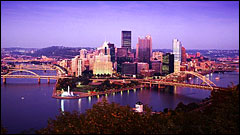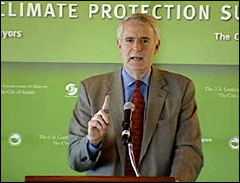For more on Rust Belt cities, see our full feature on sustainability initiatives underway in Cleveland.
It may not be intuitive to link an area historically associated with steel mills, coal mining, and automobile assembly lines to sustainable development. But green growth is catching on in the Rust Belt, long an economically unendowed area of the country — and its manufacturing-heavy past is coming in handy in emerging fields like biotech, nanotech, and hydrogen cars.
Here’s what three cities are doing to green up their acts.

A new Destiny emerges in Syracuse.
Image: destinyusa.com
Syracuse, N.Y. In late 2007, Syracuse was named the “Go Green Large City of the Year” — and this year, it will host the annual summit of the Go Green Initiative, which fosters sustainability in schools across the nation. Where was Mayor Matt Driscoll when the Go Green award was handed out? Why, he was leading a panel discussion on global warming at the U.S. Conference of Mayors summit in Seattle. Not bad for a city once best known for being a leader in the salt industry and home to the hardworking Erie Canal. In recent years, a push by city officials has seen Syracuse invest in green building and energy; its Center of Excellence in Environmental and Energy Systems unites businesses and institutions working on research and product development in clean-tech and renewable fuels. Destiny USA, a major mixed-used project powered by renewable energy, has garnered national headlines, and backers of a more local effort to revitalize the downtown corridor hope to create green-collar jobs and attract young workers. What effect will the green push have on this still-hurting city? Only time will tell.

Pittsburgh: good intentions, bad air.
Photo: nps.gov
Pittsburgh, Penn. The Smoky City has become a poster child of sorts for urban revitalization, although it still hasn’t achieved the eco-notoriety of larger metropolitan areas. As home to the nonprofit Green Building Alliance, Pennsylvania’s second-largest city has seen a boom in sustainable development, and it’s been hailed as a leader of the green-building movement — ranking third in the number of green buildings in the U.S., just behind Portland and Seattle. Efforts to redevelop riverfront brownfields have met with some success, and the city has gained new attention for its recreation access. But the challenges of its post-industrial legacy remain: The city was recently given the dubious honor of worst air quality in the nation, and sprawl is an ever-looming foe. Pittsburgh may no longer be “hell with the lid off,” as it was once dubbed, but residents and advocates acknowledge that it seems to linger in a sort of purgatory.
Milwaukee, Wisc. Once known as “the beer capital of the world,” Milwaukee has lately seen an explosion in other types of comestibles. With the state seeing a 92 percent increase in organic production from 1997 to 2001, the city has built up its local food network; it now boasts several inner-city community-garden projects, a downtown public market, an annual campaign to encourage residents to follow a 100-mile local-food diet, and citizens’ groups — both organized and ad hoc — pushing local food to the fore. A New Urbanist surge — largely attributable to former Mayor John Norquist, now president and CEO of the Congress for the New Urbanism — has seen downtown housing grow at a rate comparable to that of the ‘burbs, with affordable options an important part of the mix. Current Mayor Tom Barrett’s Green Team is working to keep sustainability at the fore, and has partnered with the Apollo Alliance to bring clean-tech jobs to the area. We’ll drink to that.



